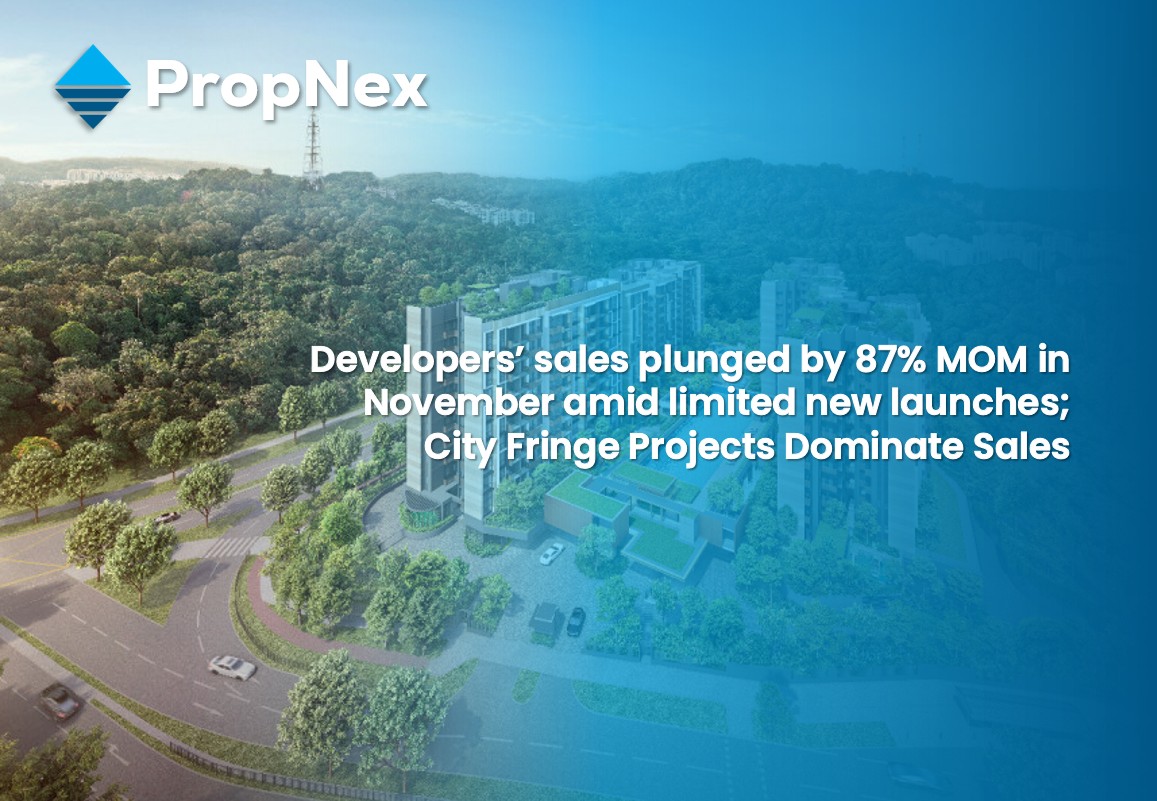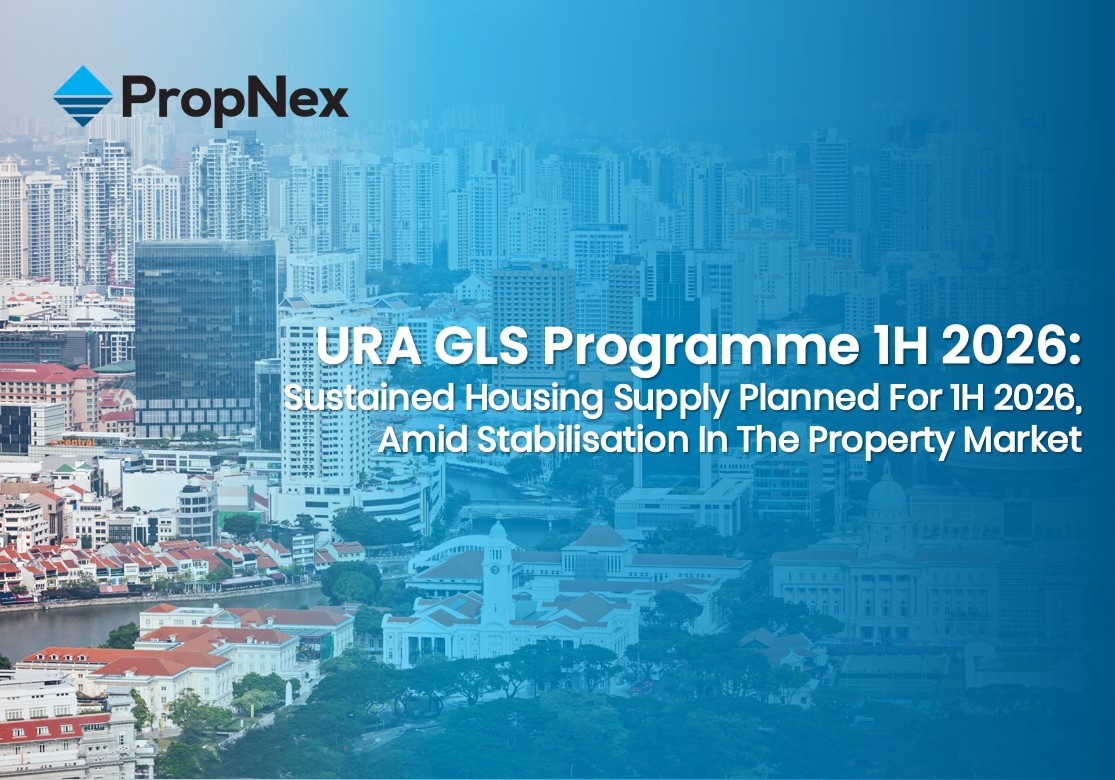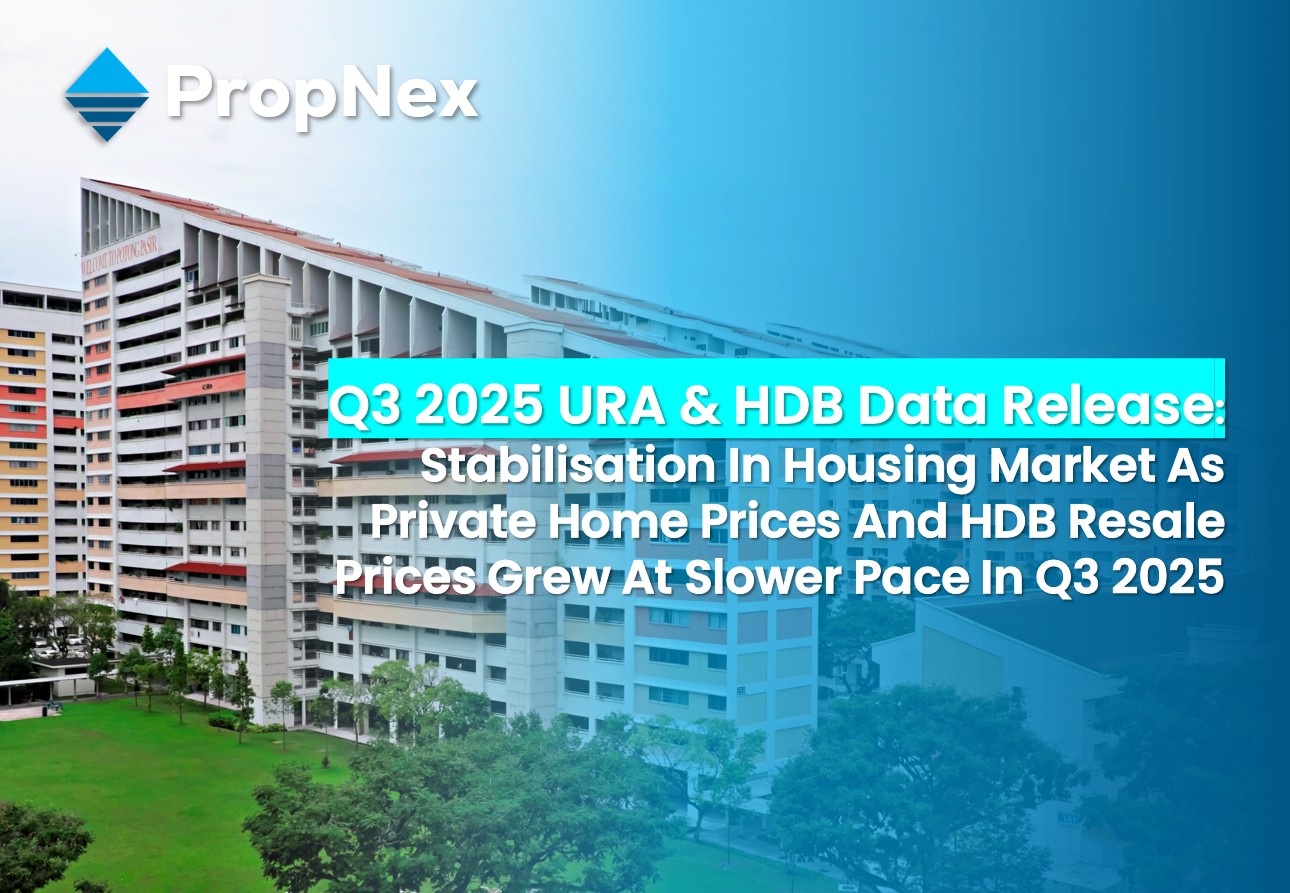Strong Growth In Private Home Prices In Q1 2023 Sparked New Cooling Measures; Price Growth Expected To Slow In 2023
28 April 2023, SINGAPORE – Home prices have stayed remarkably resilient even as interest rates started to spike from the second half of 2022. In Q1 2023, private residential property prices posted strong growth, helped by firm prices of newly launched projects and a slight increase in resale prices. The resilient demand and strengthening of private home prices have sparked a fresh bout of property cooling measures, which took effect on 27 April 2023.
Meanwhile, HDB public housing resale flat prices saw a slimmer increase, likely due to price resistance amongst buyers and as the September 2022 cooling measures continue to bite. As at Q1 2023, both the URA private property price index and the HDB resale price index booked the 12th straight quarterly price growth and are now at their respective all-time peak.
Q1 2023 URA Private Residential Property Index
Figures from the Urban Redevelopment Authority (URA) showed that overall private home prices climbed by 3.3% QOQ, accelerating from the 0.4% QOQ increase in the previous quarter (see Table 1). The final print is slightly higher than the flash estimates (+3.2% QOQ) released earlier this month.

The price increase in Q1 2023 was led by the Landed private homes segment, where prices rose for the 7th consecutive quarter by 5.9% QOQ – it is the largest quarterly price growth since Q1 2021 where prices booked a 6.7% gain. This is a sharper increase compared to the 0.6% QOQ growth in the previous quarter. It is likely supported by the 47.5% QOQ jump in the number of detached house transactions in Q1 2023; caveat data also showed that average transacted prices rose across all landed home segments from Q4 to Q1. The top landed home transaction in Q1 2023 was the sale of 3 adjoining freehold bungalows at Chancery Hill Road and Dyson Road for $61.1 million, according to caveats lodged.
Meanwhile, prices of Non-landed private homes were up by 2.6% QOQ in Q1 2023, following the 0.3% QOQ growth in Q4 2022 – supported by the firm transacted prices at new launch projects during the quarter. New launches The Botany at Dairy Farm, Sceneca Residence, and Terra Hill were the top-selling projects in Q1 2023 (see Table 2). URA data showed that developers launched 1,312 units of new private homes (ex. EC) for sale in Q1 2023 – up from 504 units in the previous quarter.

By sub-markets, the Rest of Central Region (RCR) posted the fastest price growth in Q1, with home prices rising by 4.4% QOQ, continuing a string of healthy quarterly price growth from Q2 2022. The launch of Terra Hill in the RCR has helped to support price growth in the sub-market.
Meanwhile, Core Central Region (CCR) non-landed home prices inched up by 0.8% QOQ in Q1, from the 0.7% QOQ increase in the previous quarter. Of note, the CCR was the only sub-market that posted higher new sale and resale volumes on both QOQ and YOY basis, as the slower pace of price increase likely drew more buyers into the CCR (see Table 3).
Private home prices in Outside Central Region (OCR) grew by 1.9% QOQ in Q1, reversing the 2.6% QOQ decline in Q4 2022 – partly spurred by healthy sales at Sceneca Residence and The Botany at Dairy Farm which hit the market in January and March respectively.
In Q1 2023, new home sales rebounded sharply on new projects being launched. Developers sold 1,256 new private homes (ex. EC) – up by 82% from 690 units sold in Q4 2022. New home sales were driven by the CCR which accounted for 43% of the quarter’s tally. Meanwhile, there were 2,622 resale transactions in Q1 2023, marking a 3% QOQ decline. The OCR continues to lead resale volume as the sub-market caters to a broader segment of buyers. As no new EC projects were launch in Q1 2023, sales remained muted, where 206 new ECs were sold – down from 1,127 units in Q4, where Copen Grand and Tenet drove sales.

In the private home leasing segment, rentals continued to rise in Q1 2023, increasing by 7.2% QOQ – albeit slower than the 7.4% growth in the previous quarter. This follows a robust 29.7% increase in private home rentals for the whole of 2022. PropNex expects the pace of rental increase to slow substantially in 2023, as tenants resist paying ever-higher rentals and as more completed projects come on the market. URA data showed that some 19,000 units of private homes are expected to be completed this year.
Overall, the unsold inventory of private new homes in the market remains low, and in our view, contributed to the price growth amidst healthy housing demand. The stock of uncompleted new homes stood at 16,252 units (ex. EC) as at the end of Q1 2023.
Ismail Gafoor, CEO of PropNex Realty:
“Q1 2023 marked the 12th consecutive quarter of increase in private home prices, which have jumped by about 28% over that period as per the URA PPI. Much of the price increase took place over the last 2 years and we think cost-push factors and the tight supply continued to put an upward pressure on home prices in Q1 2023. In view of the acceleration in home prices and resilient demand, the government has moved pre-emptively, hiking the additional buyer’s stamp duty (ABSD) rates from 27 April 2023.
We expect the new property measures to cool market sentiment over the next few weeks, with investment demand for big-ticket homes by foreigners to slow for a more extended period. With the 60% ABSD rate and buyer’s stamp duty, Singapore is now a significantly more expensive investment destination for foreigners, compared to many other gateway cities. As the CCR tend to see a higher proportion of foreigner demand, the latest ABSD hike is expected to affect the CCR more than the other sub-markets. CCR home prices have risen at a slower pace compared to the RCR and OCR, and the ABSD hike will likely crimp CCR price upside in the near-term.
That said, we do emphasize that Singaporeans and Singapore PRs still account for the majority of sales in the CCR. Based on URA Realis caveat data, Singaporeans and PRs purchase an average of 86.2% of new private homes in the top 10 best-selling CCR projects in 2022 (see Table 4). Therefore, these groups of buyers should continue to underpin CCR home sales, and they may benefit from less competition from foreign buyers as well.
Meanwhile, demand for homes in the RCR and OCR segments by Singaporeans and PRs should also hold up, as these sub-markets tend to see more owner-occupiers and less investment demand compared to the CCR.

We note that sub-sales have risen to 243 units in Q1 2023 – the highest quarterly sub-sale figure since Q2 2013 where there were 334 sub-sales transactions. In Q1 2023, sub-sales accounted for 5.9% of total transactions, which is a slight increase from the previous quarter but still much lower than the 11% to 13% seen in 2007-2009 when property speculation activity peaked. Various factors could have pushed sub-sales higher; some buyers may have opted to sell the units before completion due to the elevated interest rates, while others could have cashed in on price gains as values have grown in recent years.
In view of the new measures, as well as the ongoing market challenges (high interest rates, less upbeat economic outlook), we are revising downwards our forecasts for the private residential market. We are now expecting private home prices to rise by 4% to 5% for the whole of 2023, with most of the gains already front-loaded in Q1 2023. The remaining three quarters should see marginal price growth.
Meanwhile, we project that new private home sales (ex. EC) could come in at around 6,500 to 7,500 units – possibly lower than the 7,099 units sold in 2022. With a number of RCR and OCR projects due to be launched this year, we are still optimistic that developers’ sales could cross the 7,000-unit mark. Apart from 2022, the recent years where new home sales trended at the 7,000-plus level was in 2014, 2015, and 2016 (7,316, 7,440, and 7,972 units respectively) where the introduction of the total debt servicing ratio framework in June 2013 affected sales.”

Q1 2023 HDB Resale Price Index
The latest data released by the Housing and Development Board (HDB) showed that resale prices of public housing flats inched up by 1.0% QOQ in Q1 2023, slowing from the 2.3% QOQ increase in the previous quarter (see Table 5). This figure came in slightly higher than the flash estimates (+0.9% QOQ) released earlier this month. This represents the 12th straight QOQ growth in the HDB Resale Price Index, albeit also the slowest pace of price increase since the 0.3% growth in Q2 2020. In Q1 2023, 6,979 resale HDB flats were transacted, rising by 5.8% from the 6,597 flats resold in the previous quarter (see Chart 1). On a year-on-year basis, HDB resale volume was up by 0.6% from 6,934 units in Q1 2022.


Wong Siew Ying, Head of Research and Content, PropNex Realty:
“After two years of strong increase in resale flat prices (+12.7% in 2021, +10.4% in 2022), we are seeing signs of price moderation in the HDB resale market. This can be attributed to the package of cooling measures introduced in September 2022 – the tightening of LTV limits and the introduction of a 3% interest rate floor for HDB loans – as well as price resistance setting in.
The resale volume of 3-room and 4-room flats rose by 12.8% QOQ and 4.0% QOQ respectively, while the number of 5-room resale flats resold ticked up by 1.3% QOQ in Q1 2023. Transactions of executive flats, meanwhile, dipped by 3.7% QOQ in the quarter. The increase in sales of smaller flats could be due to a combination of factors such as the 15-month wait-out period and the increase in housing grants for eligible first-time buyers of 4-room or smaller resale flats. The 15-month wait-out period restricts private home owners who have sold their private residential property from buying HDB resale flats, but an exemption to the rule allows former private home owners who are seniors to buy 4-room or smaller resale flats.
The new property cooling measures introduced on 27 April 2023 are mainly targeted at curbing investment demand in the private home market. At this juncture, we do not anticipate any major shifts in HDB resale prices nor demand. That’s largely because the HDB resale and private residential markets serve buyers of different profiles and it is unlikely to see a big surge in resale flat demand due to the new property curbs on the private housing sector. We generally still expect the HDB resale market to remain stable.
One possible effect of the new measures is that HDB upgraders may take a longer time to consider their upgrading decisions. At the 17% ABSD rate previously, many upgraders had already found it quite strict. Some HDB upgraders have the financial means to pay ABSD upfront to buy a second property and apply for an ABSD refund subsequently (subject to conditions). However, others have decided to sell their flat first before purchasing a private home to avoid having to pay the hefty ABSD upfront. With the ABSD rate being raised to 20% now, we think more HDB upgraders may opt to sell their flat first before buying the second property, as some may not be able to come up with the 20% funds needed to pay the higher ABSD.
The pace of growth in HDB resale prices has outpaced that of private home prices in recent years. The new cooling measures are expected to rein in private home price growth, which will help to keep private residential properties within the reach of HDB upgraders and first-time homebuyers.
For the whole of 2023, we maintain our projection for resale flat volume to hover around 27,000 to 28,000 units, with demand for smaller flats likely to remain strong. Our forecast for HDB resale flat prices – projected to climb by 5% to 6% in 2023 - also remains unchanged.”
Suggested Reads
Upcoming Events
View moreYou may like

Developers' Sales Plunged By 87% MOM In November Amid Limited New Launches; City Fringe Projects Dominate Sales
December 15, 2025

Sustained Private Housing Supply Planned For 1H 2026, Amid Stabilisation In The Property Market
December 02, 2025

A Rare Bukit Timah Freehold Hilltop Estate Enters the Market for the First Time in 70 Years
November 21, 2025

Developers' Sales Surged To 11-month High In October, Propelled By Robust Demand For New Launches; Monthly Sales In The Core Central Region Are Highest In Over 18 Years
November 17, 2025










